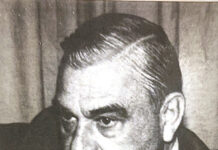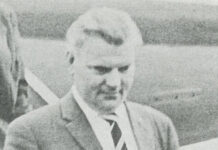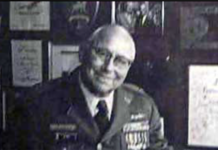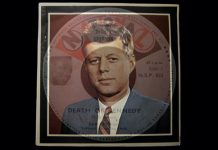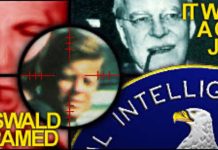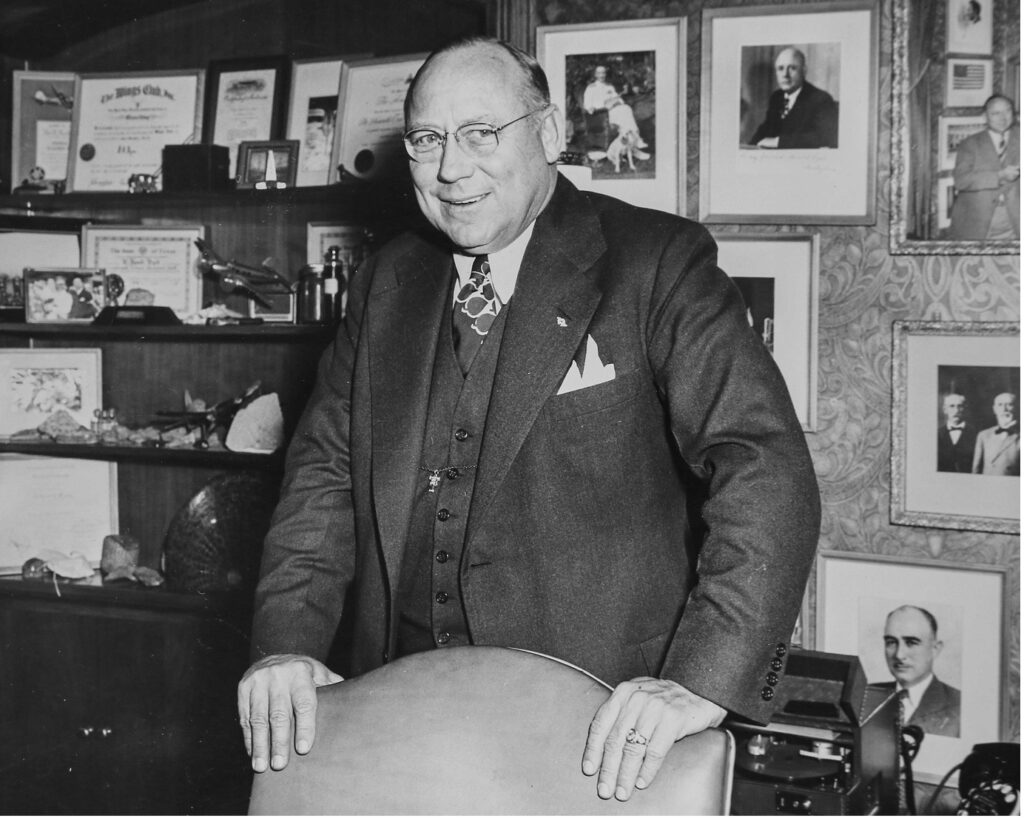
[This article is part of a special week of coverage on the continued mystery of the JFK assassination on the 62nd anniversary of the assassination.—Editors]
David Harold Byrd was the Texas oil millionaire who owned the building on Dealey Plaza rented by the Texas School Book Depository—the building that became notorious on November 22, 1963.
In all the investigation and speculation about how the alleged assassin, Lee Harvey Oswald, happened to get a job in this building that would soon overlook a motorcade route, there was little or no scrutiny of Byrd. This was partly because he was not Lee Oswald’s employer—his renter, the TSBD Company, was—and partly because he had put out the word that he was far away on safari in southern Africa in the weeks before and after the assassination.
But two years ago a striking finding was published. Byrd may not actually have been on that safari. Researchers unearthed an old photo, part of a collection snapped by the nephew of the safari camp’s German operator, that features the man who showed up at the remote safari camp claiming to be Byrd—and he bore little resemblance to the real Byrd.
The authors presented corroborating evidence as well that the so-called Byrd plus his companion were not whom they claimed to be.
To recap:
- The safari picture of “Byrd” shows a mustachioed, fairly fit, Mediterranean-looking man, whereas the real Byrd circa 1963 was rotund, clean-shaven, jowly, bespectacled, and seems different in the eyes, chin and cheekbones.[1]
- Byrd was supposedly accompanied on his hunting safari by Dr. Vanda Davidson, a leading Dallas gynecologist.[2] Yet Christian von Alvensleben, the young photographer who took the picture of the man claiming to be Byrd, says his companion called himself Thomas May (photos of whom also appear in von Alvensleben’s online gallery). No Dr. Davidson appeared.
- Another of the safari photos shows a dead elephant with these words painted on its huge ear: “Shot by Harold Byrd. 7 Dec. 1963.” Most hunters would pose for the picture with their trophy. It is hard to imagine why any hunter would paint his name on the carcass, then stay out of the picture, unless he was impersonating the person whose name he had painted.
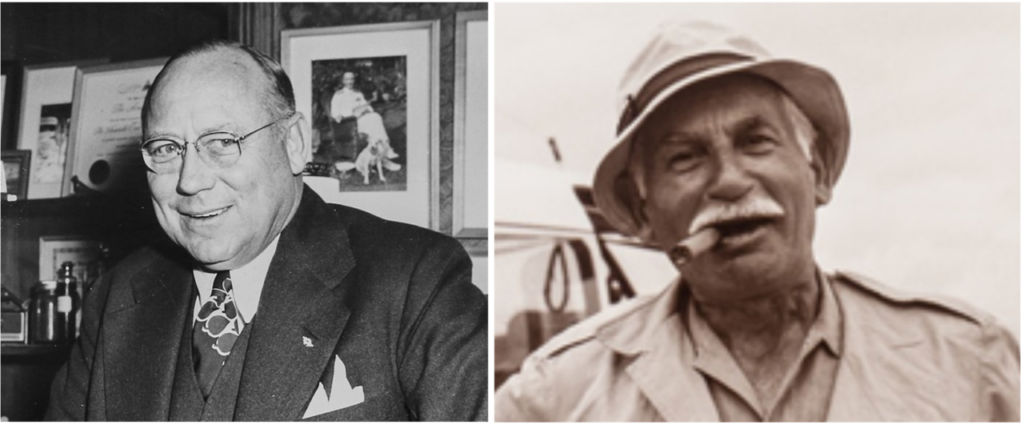
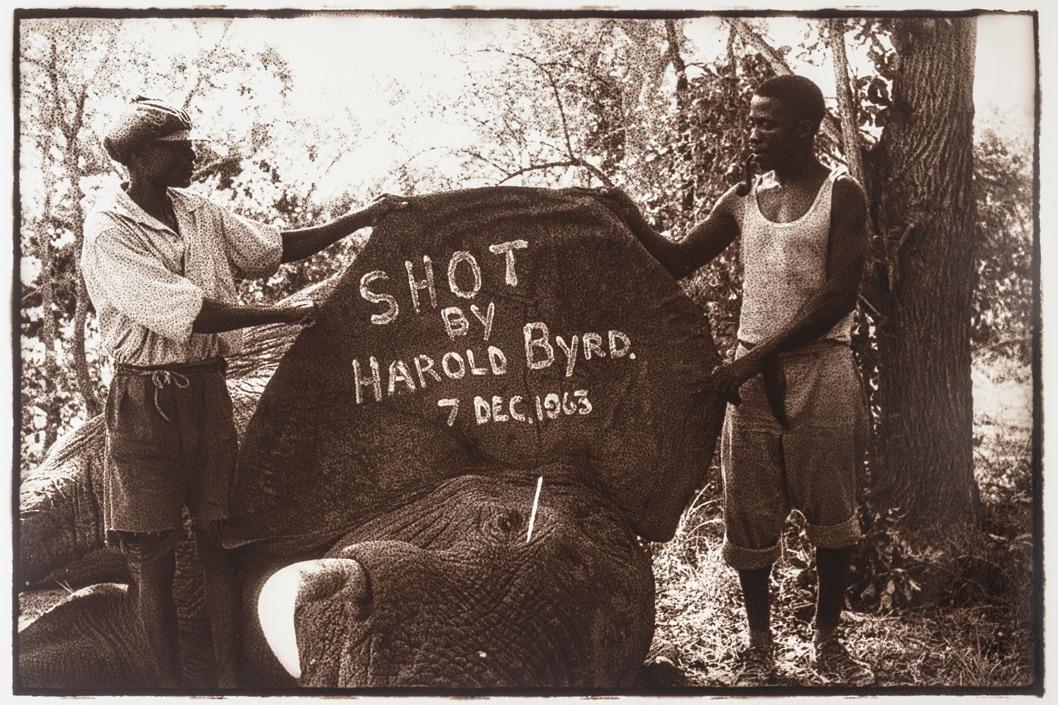
Taken together, these facts indicate that something was very wrong with Byrd’s supposed safari. The evidence even seems to show that, as strange as it may seem, Byrd sent an imposter to this far-off hunting camp in Mozambique. Now why would he do that, in the period his building was used for the crime of the century?
Despite decades of JFK assassination research, it has been incredibly rare over the last 60 years to find a strong indication (such as Jean Souètre’s deportation from Dallas a few days after November 22) that a certain individual was directly involved in the Dallas plot.
The unraveling of Byrd’s exotic safari story is one such rare instance.
To law enforcement, a false alibi is one of the strongest indicators of guilt. The JFK research community should now pivot, or new researchers should step in, to pin down everything they can about Byrd’s actual whereabouts in late November 1963, plus anything else about him that might show means, motive and opportunity.
And interested politicians like Rep. Anna Paulina Luna (R-FL) and the House Oversight and Government Reform Task Force on the Declassification of Federal Secrets should be alerted to the Byrd issue.

Basically—we have a hot lead, and should not squander it. Therefore, this article’s appendix suggests some specific next steps for researchers. Several of them would involve on-the-ground work in Texas, so JFK researchers there are particularly encouraged.
The starting point is to make some guesses about what Byrd was doing, if he was not hunting in Mozambique.
He did not just want to be away from the scene of the crime: If that were his objective, he could have gone anywhere, for real, and made his presence conspicuous. His device of creating an illusion that he was far away only makes sense if in fact he was not far away at all.
That means there were things he had to do on the ground, either because only he could do them, or no one else was trusted to do them.
Two guesses come to mind: something to do with his building, like a secret escape route; or flying some or all of the hit team out of Dallas.
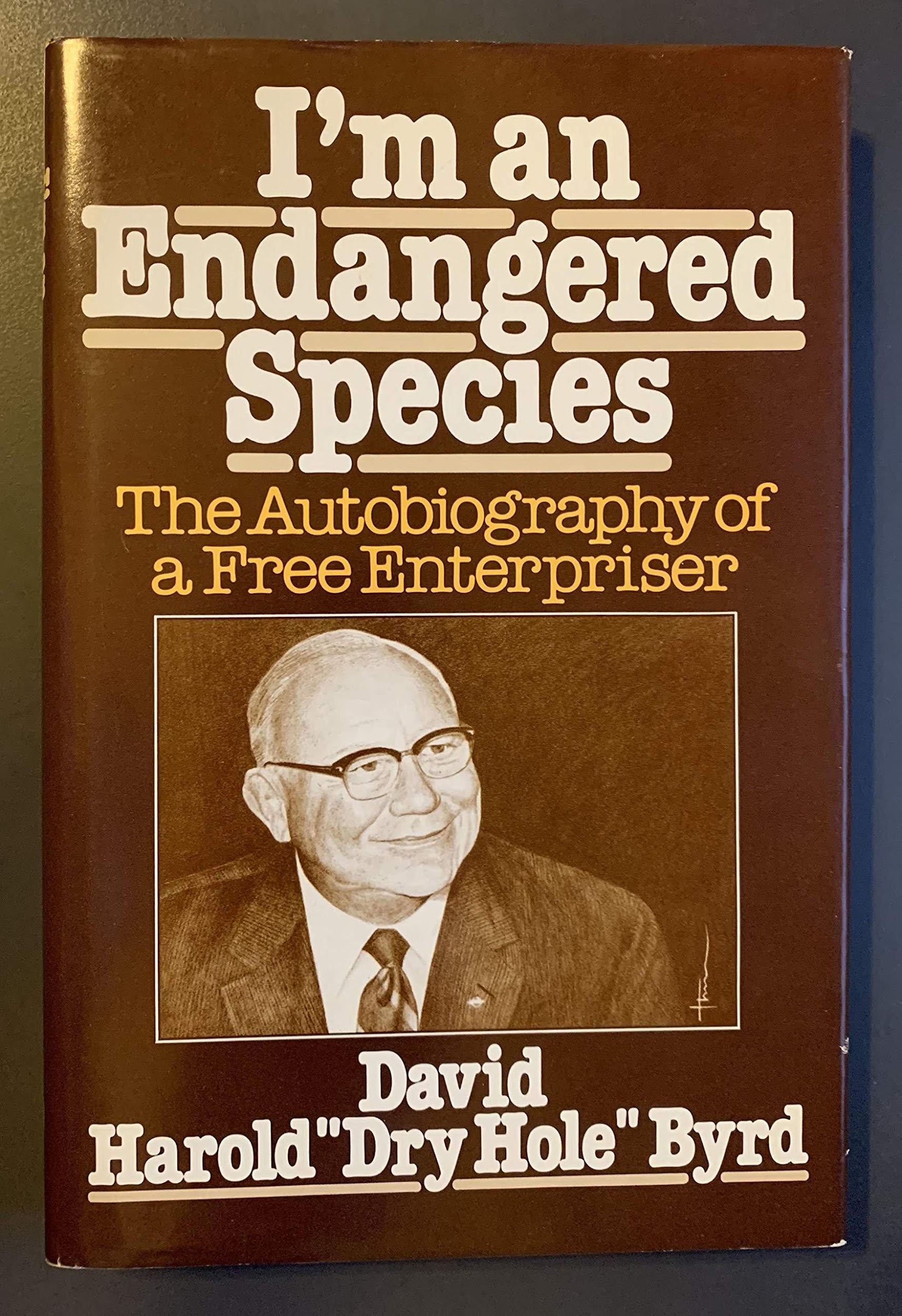
A few researchers have reacted to the November 2023 articles that cast doubt on Byrd’s safari story by expressing certainty that he did go to Mozambique as he claimed. It is healthy to interrogate the new evidence to the contrary; on the other hand, it is not clear where this certainty comes from. There is no direct evidence of it; indeed, the most direct evidence, the safari photos, tends to refute it.
Byrd did not amass his fortune by being dull, unimaginative, and sticking to the rules. In his autobiography, he boasts of his proficiency as an amateur magician—the art of illusion through misdirection.[3]
He also recounted gleefully how he obtained leases to the lands surrounding his first successful oil strike in east Texas through some shenanigans with local notaries. So in assessing his claim to have been far away from the scene of the crime, remember we are dealing with a professional and amateur illusionist.
Flying
Byrd was an experienced pilot from his early days scouting possible oil fields in Texas from the air. Once wealthy, he habitually flew a Lockheed Lodestar, a mid-sized craft similar to a DC-3. Byrd, of course, had a long history with the Civil Air Patrol, having been a co-founder in 1941, commander of the Texas and Louisiana Wing in the 1950s, vice chairman and then chairman of the national board in the late 1950s, holding the honorary rank of Colonel (later General). He had extensive aerospace holdings and was intimate with Air Force bigwigs like General James Doolittle.
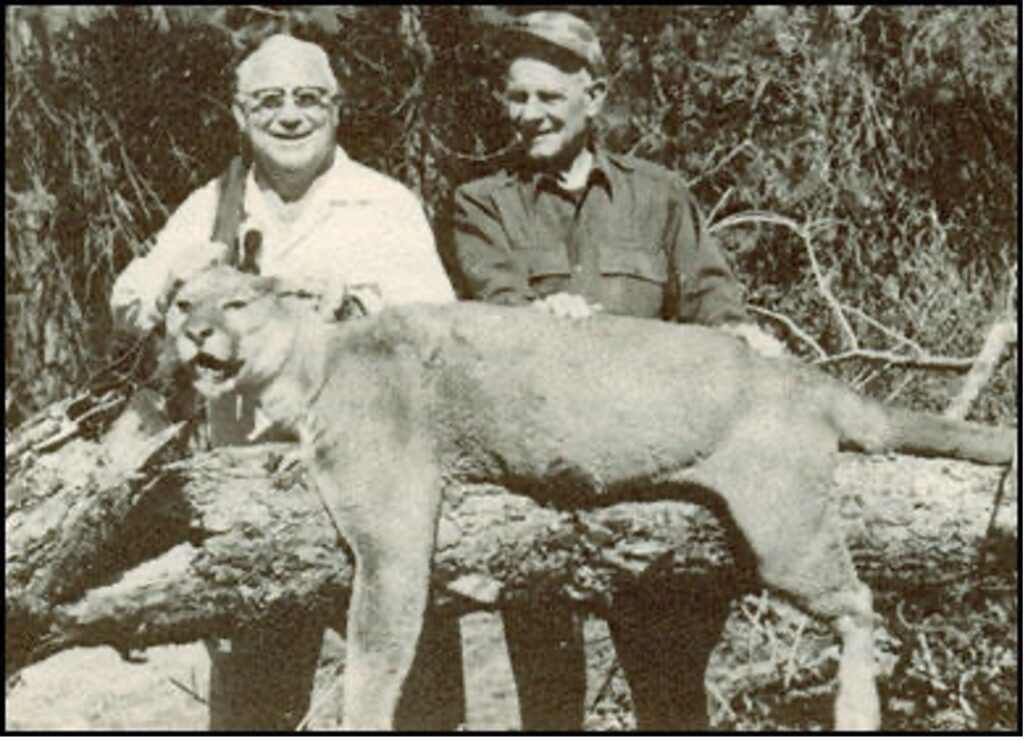
In the hours following the assassination, and before Lee Oswald was pinned with sole culpability, the federal government closed Texas’s land border with Mexico (and perhaps the whole U.S.-Mexico land border), a prudent step in case assassins were fleeing. It has not been possible so far to determine whether the air border with Mexico was closed too.[4]
James Douglass among others recounts[5] the story of Wayne January, a mechanic at Dallas’s Redbird Airport (a small field for private planes), who witnessed an unusual plane rental to depart Redbird for Mexico’s Yucatan Peninsula on the afternoon of November 22. An “Air Force colonel” was involved; however January’s description of him does not match Byrd. Still, January’s highly salient story shows that discreet flights out of Dallas were, as one would expect, a key part of the plan.
Since Byrd was experienced in flying from Texas to Mexico (where he had a second home), was a former CAP commander for Texas, and had extensive Air Force contacts, he would have been a good choice for evading or reassuring any air patrols along the border during that critical afternoon.
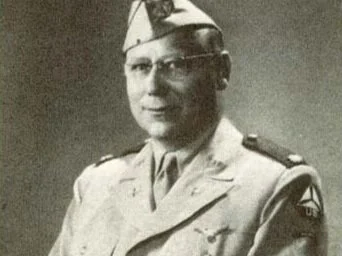
It would be useful for researchers to find out what CAP did on the afternoon of November 22, 1963—did it patrol the airspace over the U.S.-Mexico border for example? Do any surviving members remember seeing Byrd, or hearing him on the CAP radio or other aviation channels, during the critical period?
Byrd frequently flew to his house in Mexico, which was probably around Acapulco (his memoir[6] lists him as a “founder-member” of Tres Vidas in Acapulco, which currently seems to be a golf club and resort). So in the same vein, if we imagine Byrd flying fugitives into Mexico, it might have been logical for him to go to his place there, either with the fugitives or after depositing them where they could get onward transit, so as to stay out of sight.
There might be surviving local house staff—cleaners, gardeners—who could say whether they saw or heard Byrd in November-December 1963, when he was supposed to be in Africa.
Byrd’s Dealings with TSBD
There are some key unanswered questions about Byrd’s dealings with his renter, the TSBD Company, including:
- When exactly did the TSBD sign the lease and move in? Precision on this has eluded researchers for decades. The closer it was to November 1963, the more it looks like preparation for an ambush. Finding out who in Byrd’s business empire managed his Dallas real estate holdings (not Byrd himself—he would have delegated), and accessing that person’s business papers and descendants, might answer this.
- What exactly were the building renovations occasioned by TSBD’s occupancy? Was there any aspect of the work that could have played a role in the assassination? The idea of some sort of secret passage may be lurid, but the fact is that somebody got off those upper floors without being seen.[7] Contractors’ records and building-inspection reports could shed light.
- Did the assassination change Byrd’s relationship with his renter? It is amusing to envision Byrd getting back to Dallas after the assassination—if in an innocent frame of mind—and thundering at Jack Cason, the owner of the TSBD: “Cason, how the HELL did you let that Commie into my building??!…” If he did not thus remonstrate Cason for bringing his building into disrepute, that is kind of a dog that didn’t bark in the night. Cason’s personal papers, or recollections of surviving associates and family, might reveal his landlord’s reaction, if any.

Byrd’s National CAP Chairmanship
Byrd did not step back from the CAP after his command of the Texas-Louisiana wing in the early 1950s: Having served as vice chairman of its National Executive Board since 1948, he ascended to the chairmanship in 1959. He held the latter position for a year, until April 1960.
Brief though his chairmanship was, it deserves scrutiny. Did anything out of the ordinary happen? At least one thing did: on January 21, 1960, a hitherto obscure CAP pilot and trainer in Louisiana named David Ferrie was appointed as Aide to CAP National Commander Brigadier General Stephen McElroy (USAF), “for purpose of assisting in promoting the Aviation Education Program among youth.” Yes, that David Ferrie.
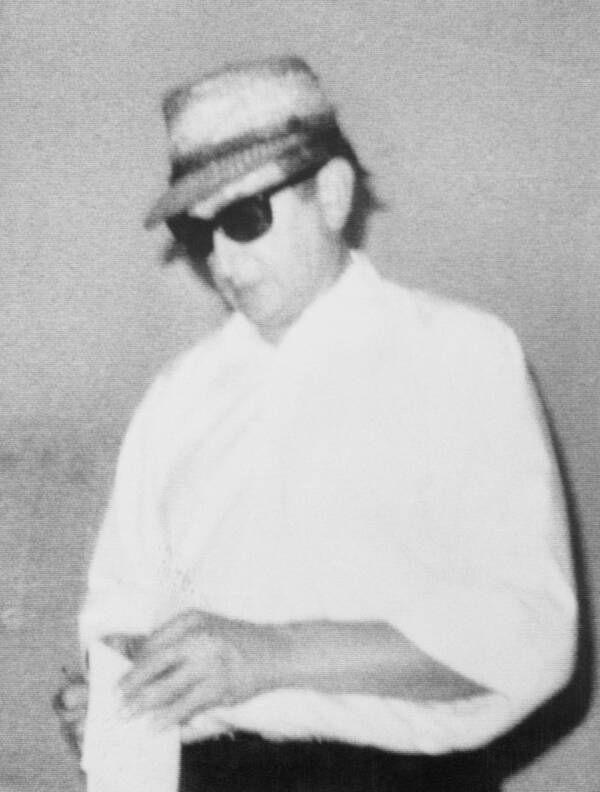
This information comes from a website called Auxbeacon.org, which mainly presented stories and apparently historical documents casting the CAP in a negative light.[8] One of its pages reproduced an apparent memo from McElroy to Ferrie, confirming the latter’s appointment as aide.
This seems significant for several reasons. It happened during Byrd’s chairmanship of the CAP board, so it opens the possibility that Byrd had a hand in it. At least it makes it likely that Byrd knew Ferrie, in person or by reputation.
A National Commander would not necessarily run every aide appointment by the chairman, but it is plausible that he might. And, conversely, if the chairman said “appoint this guy,” especially a rich and powerful chairman like Byrd, the commander would probably do it, even if he had misgivings.
And well he might. Ferrie already had a reputation at this stage for taking an unhealthy interest in youth, so appointing him to promote youth aviation seems egregious.
He would also have been in the thick of anti-Castro activities by then, possibly flying arms and/or people. Note the date—January 21, 1961—one day after JFK’s inauguration, and well into the countdown for the Bay of Pigs. It would have been all hands on deck for CIA auxiliaries like Ferrie. Promotional roles like Ferrie’s appointment are often used as pretexts for covert activities.
There is only so much we can do with this strange fact in isolation, if it is indeed a fact: The scanned memo on Auxbeacon’s page looks authentic but, of course, may be fake, known or unbeknownst to the website operators.[9]
If authentic, the nature of Ferrie’s role is unclear. It evidently was not as a day-to-day aide with an office next to the Commander’s[10] but, rather, a designated advocate on a certain topic. The title might have been largely ceremonial, akin to “The President’s Aide for Advocacy Against Youth Vaping.”
There might have been dozens of CAP pilots named to such “aide” positions. Still, it must mean something that someone prevailed on McElroy to approve the appointment of the highly eccentric Ferrie to this role that was meant to be visible.
It also seems mysterious that some time in the last year or two, Auxbeacon.org went offline. (It had posted the Ferrie appointment memo in 2019.) Is someone still covering their tracks, someone with enough pull to get whole websites taken down? Fortunately, as of this writing, the Wayback machine preserves the page, which features a scan of the memo.
Researchers can find out from the Auxbeacon operators where they got the memo and whether they authenticated it, plus why their site went down. They can also seek, through the Freedom of Information Act (FOIA), any CAP communications between National Commander McElroy and Chairman Byrd, and any mentions of Ferrie.
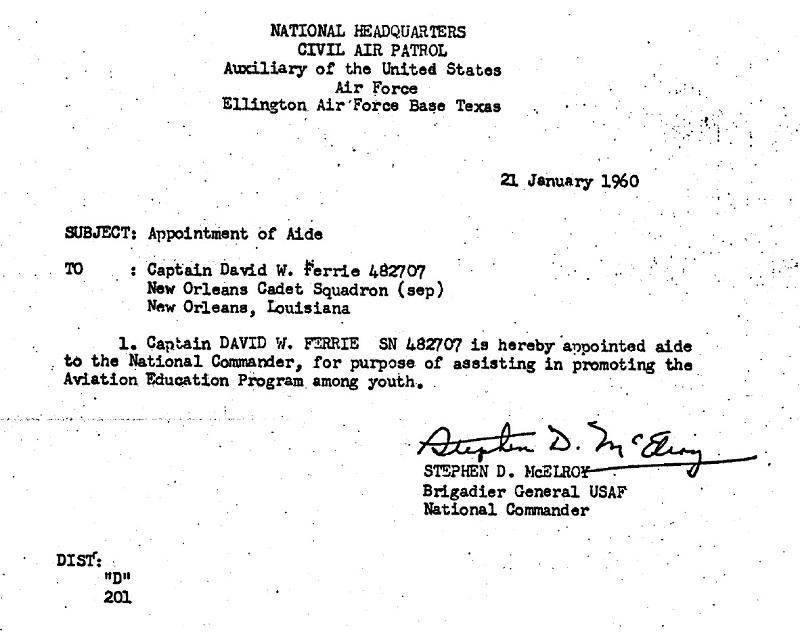
Freedom of Information lawsuit on Byrd
For some years the Assassination Archive and Research Center (AARC) has pursued FOIA litigation against the CIA to seek its records on Byrd and on the German operator of the Mozambique hunting camp, Werner von Alvensleben, to which Byrd allegedly went in November 1963.
Von Alvensleben’s story reads like a movie script: Born into a German aristocratic family, he joined the Nazi Party in 1932 at age 18, was convicted in absentia by an Austrian court (before the Anschluss) of involvement in an attempted assassination of an anti-Nazi minister, somehow fell out with the Nazis and fled for southern Africa, ended up in then-Portuguese Mozambique (which was neutral during World War II), eventually obtained a concession for a vast hunting area which he named ‘safarilandia’ and, by the early 1960s was host and hunting guide to princes, prime ministers, and captains of industry.
Visiting clients included Prince, later King, Juan Carlos of Spain, future French President Valérie Giscard d’Estaing, Greek shipping magnate Stavros Niarchos and, apparently, John Heinz of ketchup fame.[11]
As if that is not enough, he spied for the British and Americans in Mozambique during the war, and married a Portuguese siren named Bibla who was so irresistible that the chief British spy in Mozambique, Malcolm Muggeridge (later a famous author and journalist), fell for her and shared her with Werner, until he had a nervous breakdown and was pulled out.[12] In Safarilandia’s later years, until Mozambique’s abrupt independence in 1975, von Alvensleben pioneered conservation and sustainable hunting management, for which he is now fondly remembered in Mozambique.
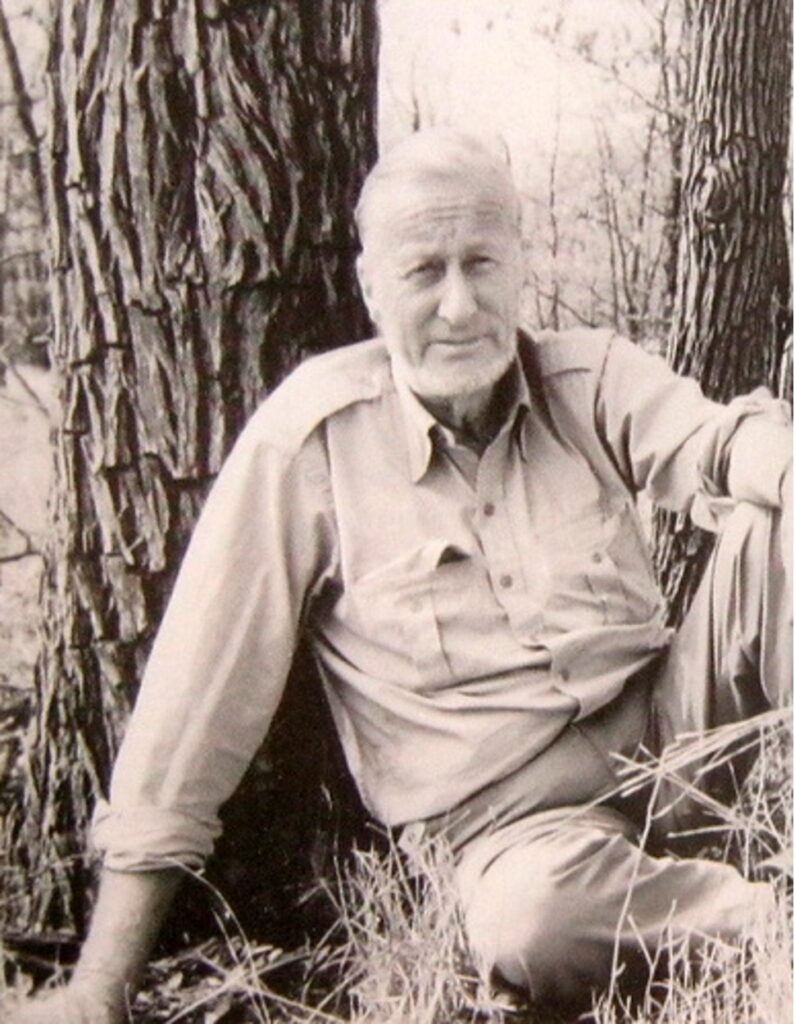
Back to AARC’s lawsuit, to make a long story short, the CIA responded to AARC’s original FOIA request by denying that it had any records on either of these two. AARC contends that is not plausible, given the prominence of both characters. Its lawsuit contests the CIA’s claim that it has searched for such records in vain.
It is an uphill struggle to argue legally that the CIA should bear the burden of proof that no such records exist; that would be proving a negative. Yet the AARC’s argument for the records’ existence is sound and would resonate with the public, especially in the current moment of unfulfilled promises of government transparency.
Surely a rich and powerful man like Byrd, with his extensive military and political connections, and surely an erstwhile spy for the OSS (the CIA’s war-time predecessor) and later hunting guide to the rich and famous, would both get some mentions in the CIA files.[13] (The OSS so valued von Alvensleben’s service that his handlers wrote a series of memos to HQ after the war seeking resettlement in the U.S. or a third country for Werner and Bibla.[14])
It looks like the CIA is hiding something. Byrd died in 1988, and von Alvensleben in 1998, so what could they have done that still necessitates secrecy?
One avenue of influence on the courts might be Rep. Luna’s JFK committee. Although apparently on pause for the time being, its members and staff, plus all those who followed it with interest, should be made aware of this issue and encouraged to pressure the relevant courts to drop any bias in favor of the CIA’s arguments in the case—perhaps by filing an amicus briefing.
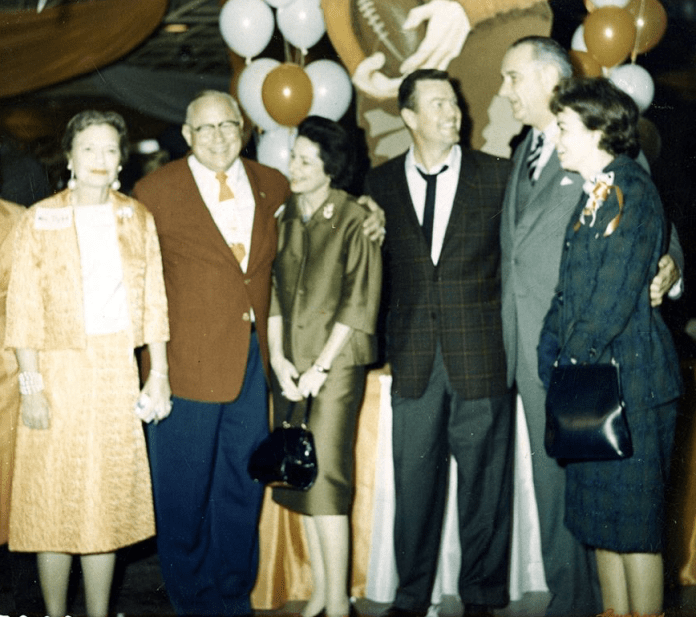
Playing Devil’s Advocate Regarding the Safari Photo
Although one’s first impression is that the guy chomping the cigar in the safari photo does not look like Byrd, there are in fact two points of similarity that have to be considered. The first is that the real Byrd had a dent in his forehead, at least by about 1972 when he appeared in a Dallas television news feature (see screenshot below). The dent is centered above the nose and about two inches above the eyebrows.
Cigar Man’s hat shades this area but, arguably, a similar dent might be discernible. The second is that the real Byrd had asymmetrical ears: His right ear was slightly lower than his left, and it stuck out more. In fact, it is kind of cauliflowered. (It looks a bit like the result of an injury, but D. H. Byrd’s father, Edward Byrd, seems to have had a similar feature—see photo below.) Cigar Man too seems to have a lower right ear and, perhaps, more protruding as well.
These are both rather distinguishing characteristics, so they cannot be dismissed. The ear is the stronger issue, since the possible dent on Cigar Man’s forehead is ambiguous in the one photo we have of him.
What is needed is facial recognition technology. Someone with the right tech knowledge should compare Cigar Man to the known photos of Byrd (of which the one at the top, of Byrd in his office, seems to be the best available that shows him around his age in 1963, i.e., 63 years old).
This technology can be very accurate, but I am not versed in which methods and software are reliable; so any volunteers for this task should please take the time to document the method and argue for its reliability.
If facial recognition confirms Byrd does not match Cigar Man, it would be useful to find out who the latter was, because his real identity might indicate who put him up to the impersonation stunt and reveal more outlines of the plot. Maybe facial-recognition software can do an “image search” to try to find a match.
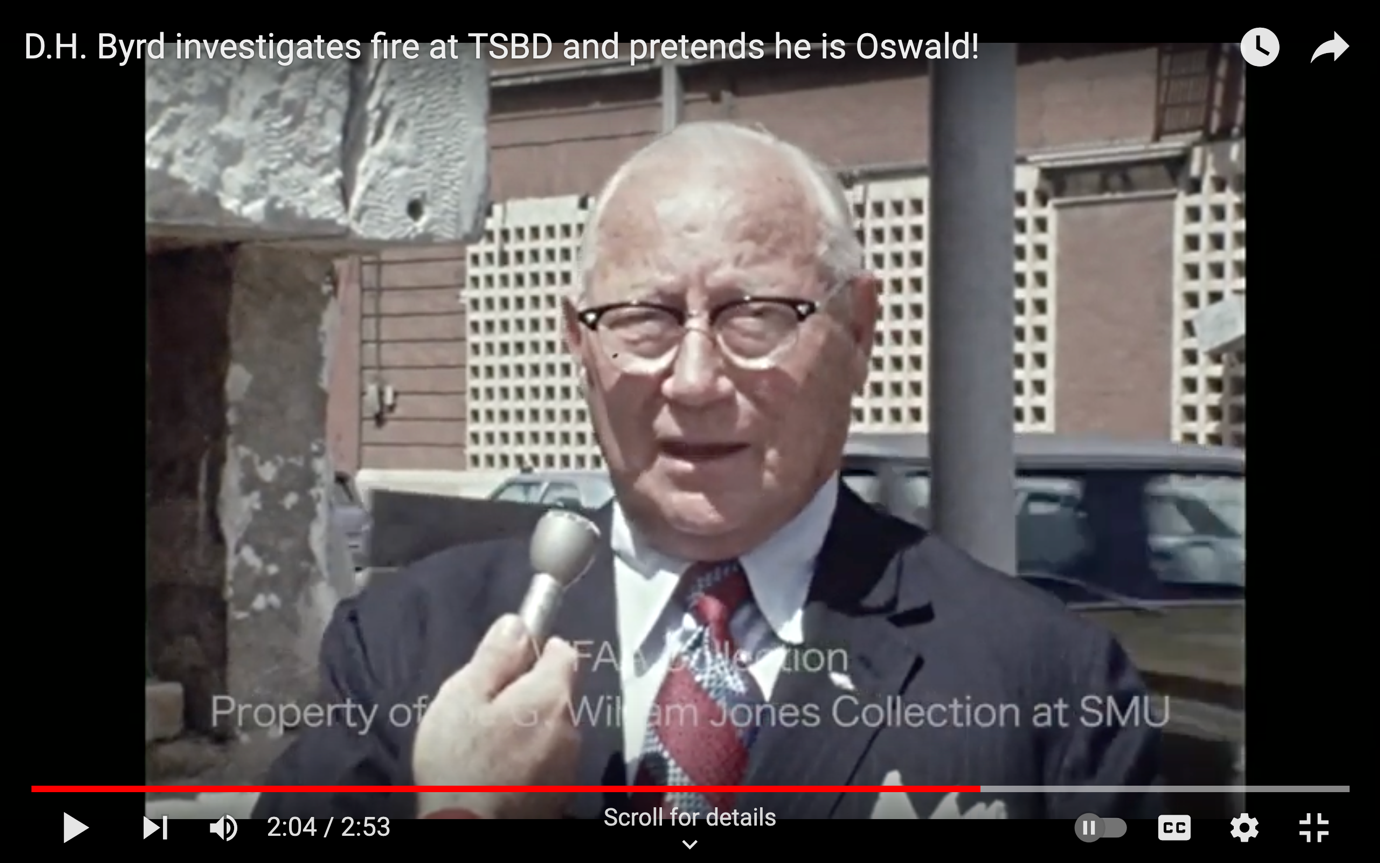
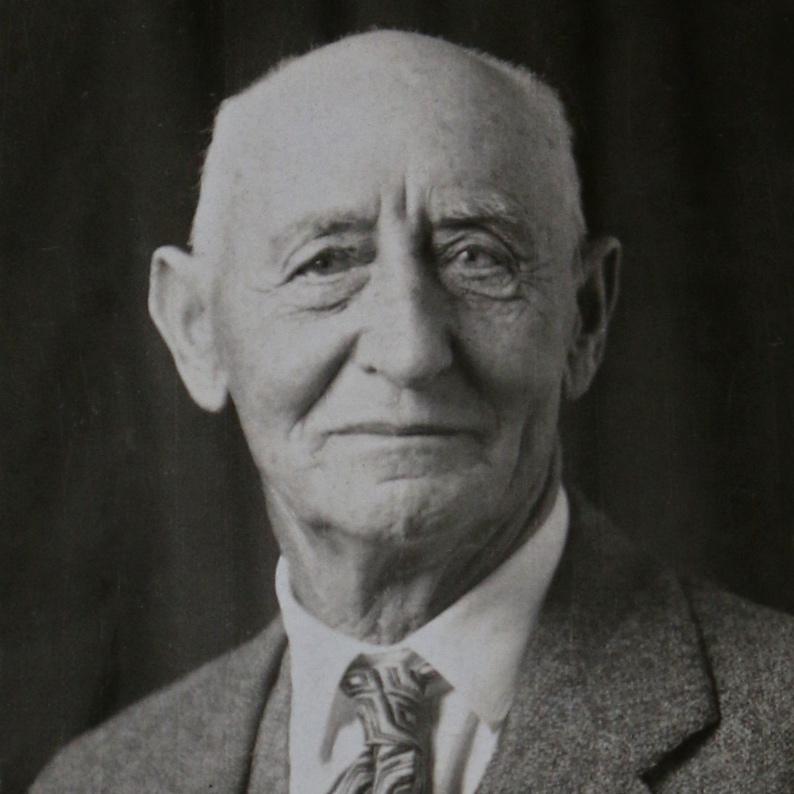
What Might Byrd’s Role Have Been?
I do not suggest that Byrd was the instigator of the putative assassination plot, nor that he was a shooter that day. (Both are theoretically possible, but there is no evidence for it.) What made his building indispensable, of course, was that a motorcade had to slow down if there was to be a good chance of success at sniping—and it overlooked the now-infamous hairpin turn.
Byrd was a hunter, but there is nothing in his background to indicate that he knew the techniques of ambushing a motorcade. So it seems more likely someone approached him, probably knowing he would have multiple motives for cooperating—his intimacy with president-in-waiting Lyndon Johnson, his aerospace holdings which a friendly administration could make enormously more valuable, and his right-wing political convictions.
Did he concoct the false safari trip, complete with imposter, entirely to avoid suspicion of involvement in the plot to which his building would be central? That does seem farfetched, even for an imaginative maneuverer like Byrd; it is a hell of a way to create a false alibi. He may have planned the November trip to Mozambique for real, some months previous, but then events intervened and he decided to capitalize on his vacation plan to create an illusion.
That would not explain, however, why he chose the wrong time of year to hunt there. (Safarilandia’s part of Mozambique has Death Valley temperatures in November.) Maybe he had planned it for the right season—the southern winter, equating to the northern-hemisphere summer—but then when the JFK plan crystallized for November, he moved the hunting trip to that time frame to explain an apparent absence. Something like that seems more likely than him conceiving the idea of booking a safari, with an outfit he had never dealt with before, with the express purpose of a false alibi.
Presume Innocence, Respect Reputations—But Follow Leads
Finally: It gives me no pleasure to impugn the memory of Byrd. Texas oil millionaires are not my cup of tea, but in most respects he does not seem to have been the worst. His surviving relatives and associates have nothing bad to say about him. And in the JFK matter he is innocent until proven guilty.
Byrd family members and associates are welcome to come forward with any evidence they can find of Byrd’s whereabouts in that critical period—old stamped passports, clear 1963 safari photos, or the like. (We should bear in mind that evidence can be faked, way back then like the elephant-ear photo or more recently.)
Still, his behavior that November of 1963 was, at a minimum, odd—enough so to oblige minute examination since it coincided with this most important of political crimes. Even if one thinks the safari photo is a close enough resemblance to Byrd, and that it really was him chewing cigars at Safarilandia, there seems much fishy about his trip.
Was he absenting himself from the scene in Dallas and positioning himself conveniently close to a refuge like South Africa, where a white man with money could live well, until he was sure there would be no blowback? Why did he not rush back to Dallas to aid the authorities in their inquiries? Or at least rush to the nearest phone (about 50 miles away on bush tracks, or a short flight by small plane) to find out what was going on with his building?
Juries have to presume innocence; investigators must follow leads.
Although in my estimation Byrd was not an instigator, if concerted research can amass further evidence of his complicity, then the outlines of the plot become clearer—who could have prevailed on Byrd to take the risk of joining, who could have guaranteed that it would be worth his while? It is well-documented that, during the Johnson presidency and Vietnam War, Byrd made a killing on aerospace stock he had bought in volume in November 1963.[15] Not many people could have guaranteed to Byrd that such stock would be in high demand once Kennedy was gone.
Appendix: Action Points for Researchers
Flying
ACTION POINT: Find out what the CAP did on November 22 following the assassination. Was it assigned to help patrol the air border with Mexico? Interview surviving members: Do any remember seeing Byrd, or hearing him on the CAP radio or other aviation channels, during the critical period?
ACTION POINT: Locate Byrd’s Mexico house; track down surviving local staff and ask if any saw or heard him in November-December 1963, when he was supposed to be in Africa.
Anyone see or hear Byrd in Dallas?
ACTION POINT: Full-court press to see if someone still alive remembers seeing or hearing Byrd (for example on aviation radio) in Dallas, or anywhere, during the period Byrd was supposed to be in Mozambique.
Byrd’s Dealings with TSBD
Who in Byrd’s operation oversaw his Dallas real estate and rentals thereof? That delegate must have been concerned that the TSBD company would be impaired by the investigation and notoriety, and Byrd might lose his new renter. She or he might also pin down when exactly the TSBD company moved into the building (which is surprisingly ambiguous despite intensive research), and what renovations were done for its occupancy.
The renovations would have needed an architect and a construction firm. Research around Dallas might reveal who those were (for example, there might have been mention in local trade papers), and those firms may possibly retain records of this job. There might have been some building-code or fire-code inspection on completion of the work.
ACTION POINT: Access Byrd’s business papers, plus any press clippings mentioning TSBD renting 411 Elm St., to identify Byrd’s real-estate manager who handled the rental. Track down that manager’s relatives and see if s/he left any pertinent business or personal records, or discussed the matter with anyone still alive.
ACTION POINT: Scour Dallas business records and trade journals for any details about the remodeling work before the TSBD moved in, for signs of any internal construction that may have been intended to prepare for the assassination.
Byrd and Cason
Jack Cason and his wife are deceased (though they said a few suggestive things over the years). But they may have offspring or relatives who remember his landlord’s reaction to the debacle. If it can be determined that there was no such reaction, that is kind of a dog that didn’t bark in the night: Byrd should have been highly unamused that his renter had brought his building into such infamy. We do know at least that TSBD’s rental and occupation of the building continued unperturbed for many years after 1963.
ACTION POINT: Track down Cason relatives and survivors, and find out what they know about the landlord’s reaction to TSBD’s role in the assassination. Ask for access to personal and business correspondence from the period.
Byrd’s National CAP Chairmanship
ACTION POINT: Track down the operators of Auxbeacon.org and find out why the website went down, plus any further information about the Ferrie memo—where they got it, whether they authenticated it, what context can they provide about the appointment, do they have any information about Ferrie’s activities in this role? Also, as background, what inspired them to create a website dedicated to critical insider accounts of and historical snippets about CAP? Why do they have an axe to grind against the CAP?
ACTION POINT: File FOIA requests for any CAP documents that mention Ferrie, plus all written communications between Byrd and McElroy during the latter’s tenure as commander, plus any third-party documents mentioning them both. (As CAP was/is an Air Force auxiliary, they may say it is a civilian, non-governmental organization not subject to FOIA, so be prepared to line up political pressure, for example, through Rep. Luna’s committee.)
ACTION POINT: Find if there is an archive of McElroy’s personal and professional papers, and scrutinize it for information about his relationship with Byrd and Ferrie.
Support AARC’s FOIA case
ACTION POINT: JFK researchers should compose and send a joint letter to the committee members advocating that they publicly support the AARC case for transparency about Byrd and von Alvensleben.
Access historical memos in NARA re von Alvensleben
NARA’s website does list several OSS memos from the 1940s mentioning von Alvensleben (who after all spied for them). Researchers have obtained and circulated on line a couple of them. However, at least five intriguing ones are still available only at NARA:
From https://www.archives.gov/iwg/declassified-records/rg-226-oss/entry-215.html:
- “Records relating to the post-war visa problems of [Baron or Count] Werner von Alvensleben, who served the U.S. as a double-agent in Portuguese East Africa during the war, ca. October 1944 – February 1947, ca. 35 pp. [WN#26069]”. (Box 5)
- “Memorandum discussing the possibility of asylum in Kenya or Tanganyika for Werner Von Alvensleben, G. E. Dedek,[16] and Maria Sousa de Costa,[17] March 18, 1944, 2 pp. [WN#26219]”. (Box 7)
From https://www.archives.gov/iwg/declassified-records/rg-226-oss/entry-216.html:
- “Report discussing the accomplishments of, and the debt owed to, Werner Von Alvensleben (Dram), Maria Sousa da Costa, and G. E. Dedek for their work in Mozambique, n.d., 2 pp. [WN#24942]”
- “Memorandum discussing the desirability of obtaining asylum in Kenya or Tanganyika for Werner Von Alvensleben, Maria Sousa da Costa, and G. E. Dedek, March 18, 1944, 2 pp. [WN#24943].”
- “Operational Reports discussing source “Dram” and other matters, June 27 – October 5, 1943, 19 pp. [WN#24944 – WN#24947, and WN#24949]”
Their titles suggest that the authors, probably von Alvensleben’s controlling OSS agent and/or their superiors, were intervening with the State Department to gain post-war resettlement for von Alvensleben in the U.S. or a third country, based on the value of his service to the OSS. We would certainly like to see the facts and arguments that these memos cite and, perhaps, further archival research could reveal why the U.S. government decided against resettling its former agents as their handlers requested. And for the purposes of AARC’s suit, these memos’ content is likely to support their claim that an asset considered that valuable would not have been written off and ignored when the OSS was reconstructed as the CIA—especially not during the Cold War when the U.S. government greatly feared the advance of communism in newly liberated African states.[18]
ACTION POINT: Researchers to go to NARA to obtain, replicate and circulate these memos to strengthen the case that the CIA must have files on Werner von Alvensleben, since these memos presumably show that he was seen as a valuable intelligence asset around the time of the CIA’s founding. By extension, it should also have files on Byrd at least because of his association with von Alvensleben.
Form a DH Byrd research group
These action points will have to be done in various locales—Washington, D.C., Texas, Mexico and, potentially, Portugal and even southern Africa.[19] It calls for a collaborative approach, preferably a research group, expressly formed or as an area of action under an existing group. If our hunch is correct—that Byrd’s alleged safari was in some way a false alibi for the assassination period—Byrd covered his tracks well; therefore, it will take more than a solitary researcher to search exhaustively for corroborating indications of his possible complicity.
The JFK research community is chronically competitive, but this would be a good occasion and topic on which to collaborate so as to organize these action points and divide the labor. If such a group succeeds in finding strong indications, there will be glory enough to share.
The group should comprise a critical mass of the handful of researchers who have been looking closely at Byrd, plus others who bring various capabilities to the table and a commitment to deliver.
ACTION POINT: Constitute a Byrd research group, either freestanding or under the auspices of some existing JFK action group.
Follow-up on safari photos
ACTION POINT: Someone with technical know-how about facial recognition apply it to confirmed high-resolution Byrd photos in comparison to Cigar Man. Also, try an image search for Cigar Man to identify him.
It would also be helpful to identify the “Thomas May” who appeared at Safarilandia with the purported Byrd and whom Christian von Alvensleben photographed there. His identity could reveal more outlines of the false-alibi plot, if that is what it was or, conversely, May might have left some records that validate the claim that the real Byrd was there (though that is hard to imagine, since Byrd’s companion was supposed to be Dr. Davidson, not Thomas May). The safari photos of May may not be high-enough resolution for facial-recognition software and, of course, there would have to be a comparison photo of “May” somewhere on line, but it should be tried.[20] Also, do an image search for May’s face to identify him.
Lastly, a perhaps wild idea to check out if analysis confirms that Cigar Man’s right ear does resemble the real Byrd’s: Since Byrd’s father had a similarly eccentric ear, check photos of Byrd’s brothers and other close male relatives, just in case Byrd used the trick of sending a resemblant relative to impersonate him.
On the issue of how Byrd booked the safari, and whether he initially booked it for a more suitable season than November, Safarilandia may have advertised in upmarket U.S. hunting magazines. Such ads would mention the U.S. agent for bookings, and that agency may still have old business records or surviving employees who remember Safarilandia bookings. If no ads can be found—Safarilandia may not have needed them—research could determine what were the top 10 or 20 agencies for expensive hunting vacations, and track down each. Old Safarilandia clients might still be around who remember how they booked (such as Neale Perkins, who named his holster business after Safarilandia).
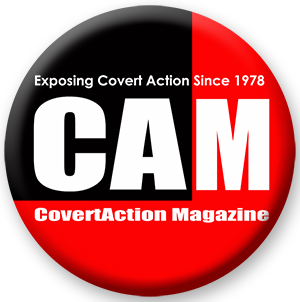
For a previous CovertAction Magazine article about Byrd, see here. ↑
See “Baron Takes a Look at Texas Hunters,” Dallas Morning News, January 19, 1964. ↑
David Harold Byrd, I’m an Endangered Species: Autobiography of a Free Enterpriser (Houston: Pacesetter Press, 1978), p. 40. ↑
According to journalist Nerin Gun [Red Roses from Texas (London: Frederick Muller Limited, 1964), p. 157], international flights from Dallas’s Love Field were taking off normally, with no searches or examinations of passenger lists, at least from about 5:00 p.m., which he found surprising. On the other hand, the FAA was alert to the possibility of a getaway by air. Daniel Hopsicker obtained an account in 2004 from Louis Gaudin: “I was an air traffic controller working in the tower at Redbird [sic] that day. When I came on shift at 2 PM, we received a bulletin to report any suspicious activity immediately to an FAA Security number.” [Daniel Hopsicker, Barry & “the Boys”: The CIA, the Mob and America’s Secret History (Walterville, OR: Trine Day, 2006), cited by Linda Minor, “Etiology of the Red Bird Getaway Plane Story,” April 7, 2015. I have been unable to access Hopsicker’s book directly.] ↑
James Douglass, JFK and the Unspeakable: Why He Died and Why It Matters (Maryknoll, NY: Orbis Books, 2008), p. 371. ↑
Byrd, I’m an Endangered Species, p. 108. ↑
Enough eyewitnesses reported seeing at least one rifleman on various upper floors of the TSBD that we can take it as a fact. ↑
Credit to Greg Parker, who found and posted the (now defunct) Auxbeacon.org link to this memo in April 2020 (https://gregrparker.com/forums/topic/ferrie-made-an-aide-to-cap-national-commander/), and to James Day, who cited this little-known fact in January 2024 (https://jamesfday.medium.com/the-jfk-assassination-new-link-between-the-civil-air-patrol-and-wandering-bishops-2b42634449ec). ↑
For example, as you see in the reproduction below, the sender’s address at the top—“National Headquarters” etc.—is typed as part of the memo, not pre-printed in letterhead. One would think the CAP national HQ would have letterhead. ↑
In that period the CAP’s national headquarters was at Ellington Air Force Base, near Houston, Texas. ↑
A nostalgic Mozambique-hunting blog (http://faunabraviademocambique.blogspot.com/2007), in Portuguese, lists several clients of the famed guide Manuel Posser de Andrade, who worked at Safarilandia for a while. On this list is “Heinz (o senhor de molhos)” (‘the lord of sauces’ or ketchup). ↑
Muggeridge wrote of this love triangle in his memoir, Chronicles of Wasted Time Number 2: The Infernal Grove (New York: William Morrow, 1974, pp. 167 et seq.), thinly disguising the other two as ‘Johann von X’ and ‘Anna.’ See also E. D. R. Harrison (2007) “On Secret Service for the Duce: Umberto Campini in Portuguese East Africa, 1941-1943.” The English Historical Review, Vol. 122, No. 499, pp. 1318-49. ↑
Lars Schall examines the Byrd-von Alvensleben history minutely in this two-part article (in German only): https://www.larsschall.com/2017/11/21/jfk-und-operation-walkuere-teil-/https://www.larsschall.com/2017/11/24/jfk-und-operation-walkuere-teil-2/- Listed on these pages, but apparently not available on line: https://www.archives.gov/iwg/declassified-records/rg-226-oss/entry-215.html https://www.archives.gov/iwg/declassified-records/rg-226-oss/entry-216.html ↑
First revealed by Peter Dale Scott, The Dallas Conspiracy (unpublished manuscript circa 1971); also detailed in Scott’s subsequent publications. See also Jeremy Kuzmarov, “LBJ Insiders D.H. Byrd and James Ling Bought 132,000 Shares of Stock in Defense Contractor LTV in November 1963 Around Time of the JFK Assassination,” CovertAction Magazine, November 21, 2024 (https://covertactionmagazine.com/2024/11/21/lbj-insiders-d-h-byrd-and-james-ling-bought-132000-shares-of-stock-in-defense-contractor-ltv-in-november-1963-around-time-of-the-jfk-assassination/). ↑
A German hunting guide who later worked for von Alvensleben at Safarilandia. ↑
That is Bibla, von Alvensleben’s Portuguese-Mozambican wife. ↑
Portugal, with its quasi-fascist dictator Antonio Salazar, was the hold-out in European de-colonization of Africa: It did not allow independence for its African colonies (Mozambique, Angola, Guinea-Bissau, Cabo Verde, and São Tome/Principe) until 1975, five years after Salazar’s death and one year after a popular and military uprising overthrew his successors in the “Carnation Revolution.” In the 1960s and early 1970s, Portugal made common cause with the other great hold-outs—South Africa and Rhodesia—such that, together, they controlled most of Africa’s vast Southern Cone. Still, Mozambique’s neighbors Tanzania and Zambia were independent, majority-ruled, and committed to liberation of all southern Africa; so Mozambique was on the front lines of the late-stage colonial struggle in which the CIA took great interest. They would have wanted to keep in touch with any current, former or potential assets there. ↑
Mozambique is unlikely to have retained any immigration records from before the upheaval of its abrupt independence in 1975, but it would be useful to check South African records and those of other neighbors of Mozambique to see if Byrd or his imposter, plus his supposed companion Dr. Davidson and/or the Thomas May witnessed at Safarilandia with the purported Byrd, transited through or tarried there in November 1963. Conceivably, Portugal might retain immigration records from its then-colonies; to be thorough, therefore, the Portuguese archives should be checked for any comings and goings by Byrd. While we are at it in southern Africa, researchers should track down the history of Permindex once it moved its headquarters to Johannesburg in the early 1960s. This move was necessitated by Switzerland’s and Italy’s expulsion of Permindex on suspicion of it supporting assassination attempts against French President Charles de Gaulle. Find out where it set up shop in Johannesburg, who its leadership and staff were, what its activities were, and what connections it made to the apartheid government. An able local researcher could do this under instruction. ↑
- Greg Parker identified a Thomas May in Arizona on Ancestry.com (login needed) who was in the right age range and had some connection to the Civil Air Patrol, and thus is a candidate to be the man at Safarilandia. To confirm this, researchers would need to see a picture of him—maybe available through his descendants or local newspapers—and/or get recollections from his surviving relatives or associates as to whether he made the hunting trip to southern Africa in November 1963. If so, we’d like to know how he knew Byrd, and whether he knew Davidson, whose place he apparently took, unbeknownst to Davidson’s family.
CovertAction Magazine is made possible by subscriptions, orders and donations from readers like you.
Blow the Whistle on U.S. Imperialism
Click the whistle and donate
When you donate to CovertAction Magazine, you are supporting investigative journalism. Your contributions go directly to supporting the development, production, editing, and dissemination of the Magazine.
CovertAction Magazine does not receive corporate or government sponsorship. Yet, we hold a steadfast commitment to providing compensation for writers, editorial and technical support. Your support helps facilitate this compensation as well as increase the caliber of this work.
Please make a donation by clicking on the donate logo above and enter the amount and your credit or debit card information.
CovertAction Institute, Inc. (CAI) is a 501(c)(3) non-profit organization and your gift is tax-deductible for federal income purposes. CAI’s tax-exempt ID number is 87-2461683.
We sincerely thank you for your support.
Disclaimer: The contents of this article are the sole responsibility of the author(s). CovertAction Institute, Inc. (CAI), including its Board of Directors (BD), Editorial Board (EB), Advisory Board (AB), staff, volunteers and its projects (including CovertAction Magazine) are not responsible for any inaccurate or incorrect statement in this article. This article also does not necessarily represent the views the BD, the EB, the AB, staff, volunteers, or any members of its projects.
Differing viewpoints: CAM publishes articles with differing viewpoints in an effort to nurture vibrant debate and thoughtful critical analysis. Feel free to comment on the articles in the comment section and/or send your letters to the Editors, which we will publish in the Letters column.
Copyrighted Material: This web site may contain copyrighted material the use of which has not always been specifically authorized by the copyright owner. As a not-for-profit charitable organization incorporated in the State of New York, we are making such material available in an effort to advance the understanding of humanity’s problems and hopefully to help find solutions for those problems. We believe this constitutes a ‘fair use’ of any such copyrighted material as provided for in section 107 of the US Copyright Law. You can read more about ‘fair use’ and US Copyright Law at the Legal Information Institute of Cornell Law School.
Republishing: CovertAction Magazine (CAM) grants permission to cross-post CAM articles on not-for-profit community internet sites as long as the source is acknowledged together with a hyperlink to the original CovertAction Magazine article. Also, kindly let us know at info@CovertActionMagazine.com. For publication of CAM articles in print or other forms including commercial internet sites, contact: info@CovertActionMagazine.com.
By using this site, you agree to these terms above.
About the Author

Rob Smith worked in humanitarian and development aid for 30 years, with NGOs and the United Nations.
Rob holds a PhD in social science from the University of London and has published in several research journals.
He hails from the Boston area originally and lives in Switzerland. His current-affairs analyses are on Blackthorn.substack.com.

